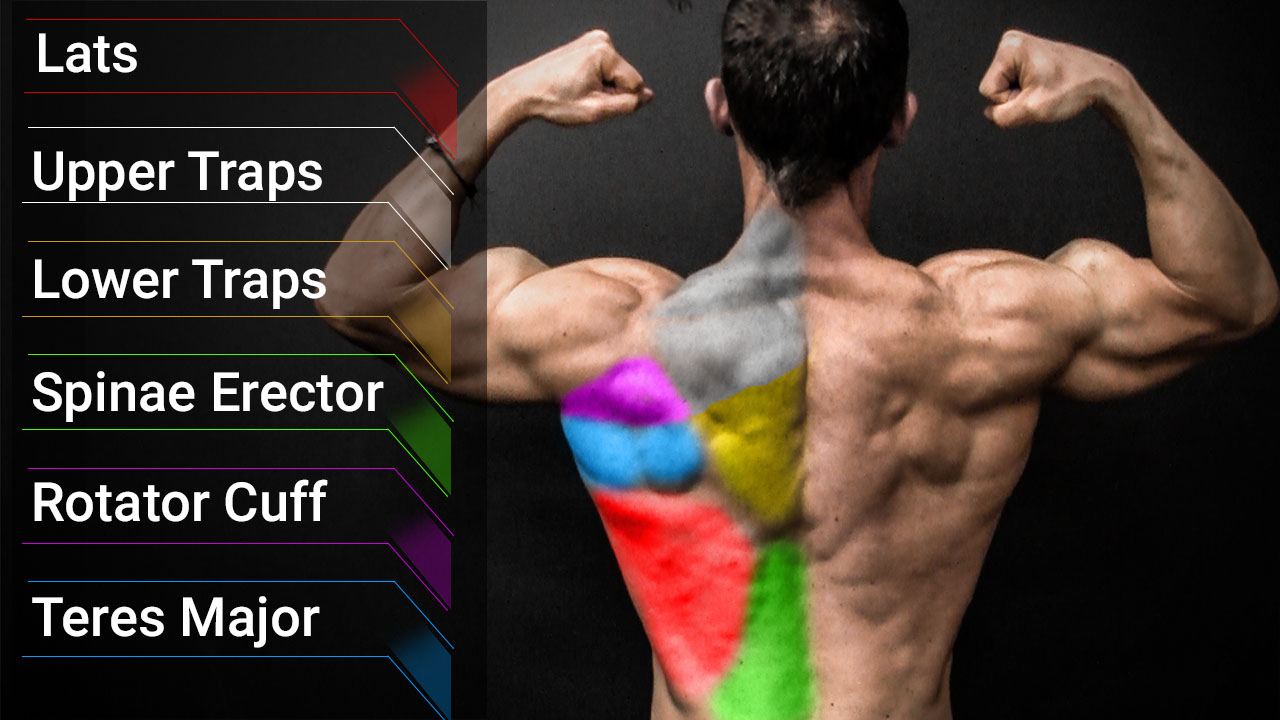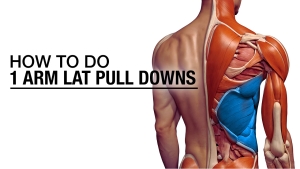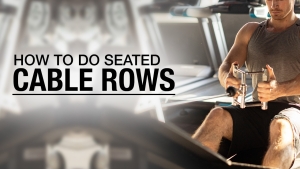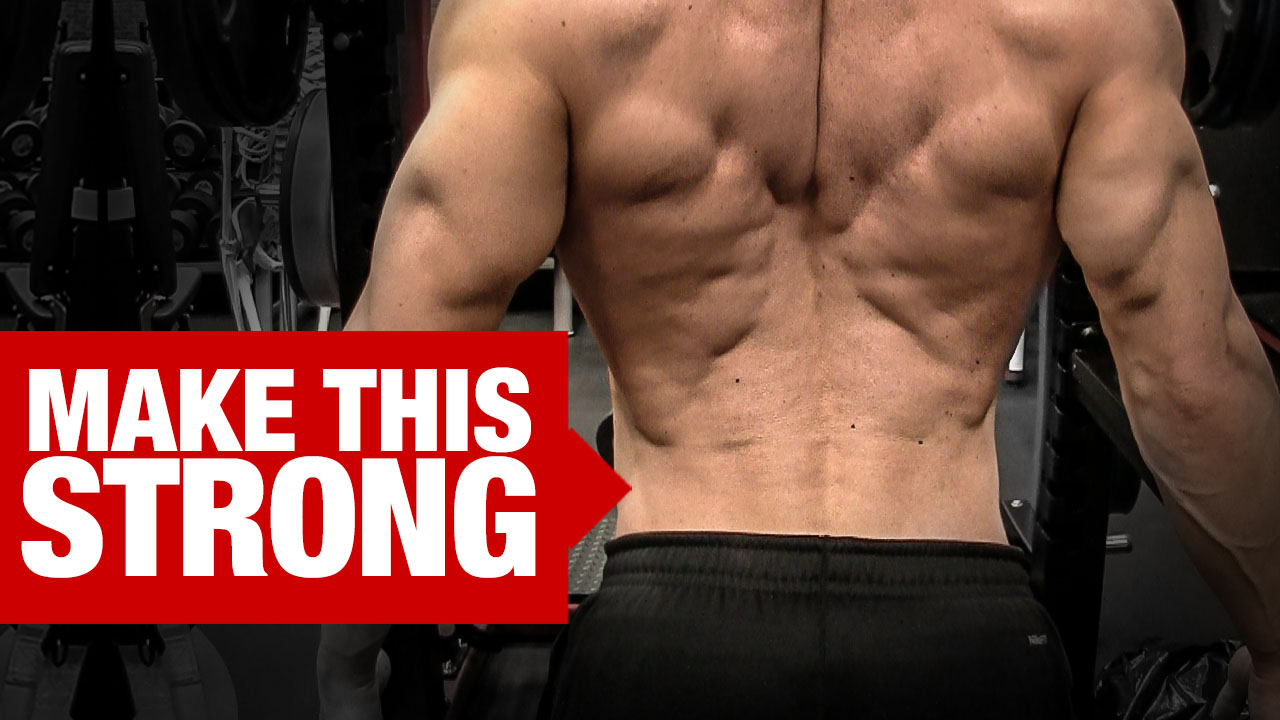
LOWER BACK PAIN WORKOUT PLAN
Let’s face it. The only time you really think about your low back is when there’s pain! Not anymore.
The lower back is at the center of practically every heavy lift you do. If it’s not strong, you are in big trouble!
And low back pain is one of the most common ailments for people who spend time strength training as well as the general public.
So today I want to give you four strengthening exercises for the lower back that you can do at home with no equipment to help fortify the back against all future injuries.
You see, your low back needs to be strong for lifting heavier weights, but it will never be strong enough unless it gets help from your gluteal muscles. If the glutes and low back aren’t working together, you’re going to find that lower back pain will set in at some point down the line when you go to do your heavy lifting (compound movements). This would include things like a barbell deadlift, Romanian deadlifts, bent-over row and other common back exercises and lower body movements.
However, if the lower back gets an assist from the glutes, it will help you get strong and remain strong in your pursuit of building bigger muscles safely.
Below I’m giving you a complete workout routine to strengthen the muscles of the lower back with help from the gluteus maximus. You can do this entire bodyweight back routine in just a few minutes with no equipment at all.
The best part about this is that it will work if you are already prone to low back pain. And even if you’ve never had any back problems (YET!) it will help you keep it that way and improve athletic movements. The best workout for lower back pain is the one that helps you prevent it in the first place!
So that you’re familiar with the lay of the land when it comes to the back, below is a graphic of the upper back muscles and the lower back muscles. For our purposes, the spinae erector muscles are the main low back muscle we’ll be talking about.
LOWER BACK WORKOUT AT HOME
The lumbar spine is meant to be a stable area that is less susceptible to injury and muscle strains and able to hold up to the rigors of heavier lifting and strenuous training.
However, prolonged sitting and bad posture cause the lower back muscles to become dormant and underactive. Then, when you ask your lower back to do too much work in your resistance training sessions, it can easily break down and leave you on the sideline unable to get to the gym.
Good lower back workouts include assistance from the glutes to help with extension of the posterior chain from the bottom up. It’s important to regularly train these muscles to help improve their muscular endurance.
It’s a lot more likely you’re going to fit in a series of movements to build the lower back if you can do them anywhere, anytime. Do this short lower back workout regularly to help with building strength and lower back injury prevention.
1.) FROG GLUTE BRIDGE – 10 REPS (HOLD EACH FOR 5 SECONDS)

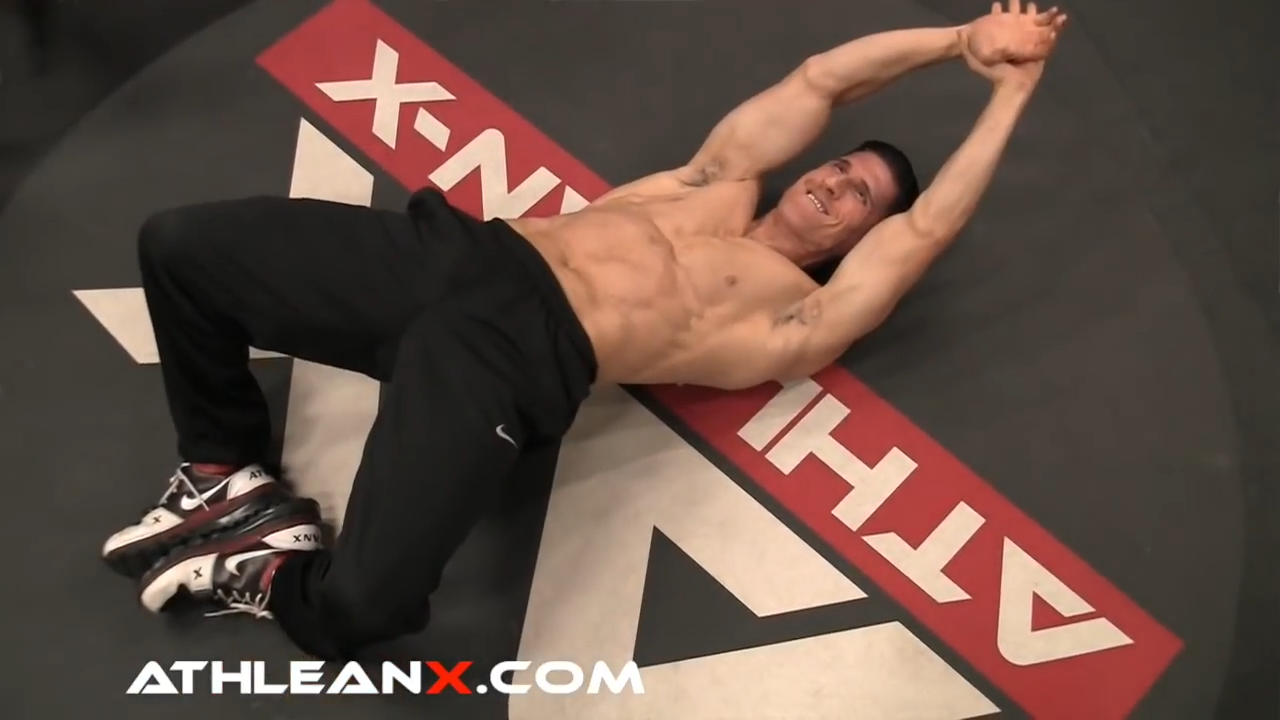
HOW TO DO THE FROG GLUTE BRIDGE:
- The first of the lower back and glute exercises is the Frog Glute Bridge. Starting position for this basic bodyweight exercise is lying with entire spine flat on the floor, knees bent, with your feet turned out on their outside edges, sides of feet flat on the floor.
- Then bridge up as high as you can keeping hips level, squeezing your glutes and low back and keeping the entire core tight.
- Make sure to contract your lower back and gluteus muscles at the same time and then lift off the floor. Slowly lower to return to the starting position.
- Hold the position, pausing at the top for 5 seconds and repeat for 10 reps. Keep your abdominal muscles engaged during the exercise.
WHAT MAKES IT EFFECTIVE: The turning out of the feet allows you to activate the gluteus medius, a hip external rotator and muscle that feeds into the pelvic bones as well. This is an excellent exercise to activate the glutes and lower back together.
2.) LAT BRIDGE HOLDS – 10 REPS (HOLD EACH FOR 5 SECONDS)

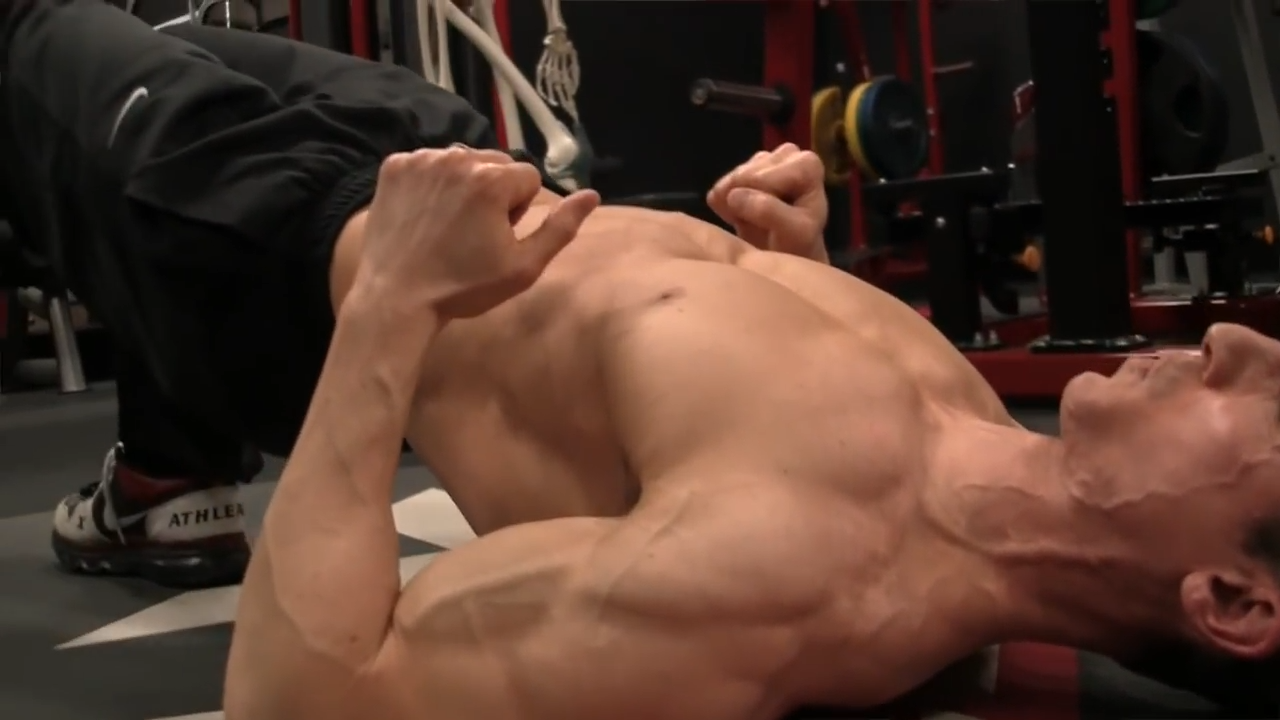
HOW TO DO LAT BRIDGE HOLDS:
- For this posterior chain exercise we want to engage the lat muscles that feed down into the lower back and pelvis. Starting position for this movement is lying on your back on the floor with your elbows close to your sides, bending your knees with feet flat on the floor, shoulderwidth apart.
- As you drive your elbows into the floor, pull your shoulder blades off the ground and squeeze up into the bridge. You can think of this as trying to do a row into the floor.
- Contract the low back and the glutes, as well as your abdominal muscles and then to put that nail in the coffin you extend one leg out in a straight line parallel to the floor for 5 seconds, and then switch to the opposite leg for 5 seconds.
- Focus on proper form, not allowing your hips to drop or your pelvis to tip as you switch from one leg to the other. Repeat for 10 reps.
WHAT MAKES IT EFFECTIVE: This is a challenging and intense exercise for strengthening your lower back and glutes.
3.) ANGEL OF DEATH – 10 REPS (5 SECONDS UP, 5 SECONDS DOWN)


HOW TO PERFORM THE ANGEL OF DEATH:
- For this body weight exercise you start out flat on your stomach with a neutral spine. Most lower back workouts for men include some sort of prone exercise in which you raise your upper body off the floor. However, moving only the top part of your body isn’t enough, because we need to get the glutes involved, too.
- Lift the toes, knees and thighs off the ground with legs straight along with the upper body, as high as you can to get extension through the hips and glutes. Keep knees slightly bent to keep them off the ground.
- Squeeze your shoulder blades to pull your chest off the floor while maintaining tight core muscles (transverse abdominis, the deep core muscles).
- Take a deep breath and then take a five second cadence to move your hands from an overhead position in an arc all the way down to your sides, maintaining a slight bend in the elbows. Rotate your hands to palms facing together as you come up and then rotate your hands to palms facing up as you go down.
- Take five seconds to go the entire range of motion from the top to the bottom, and then five seconds to back up to the top. Don’t lower your torso or your leg muscles until your 10 reps are complete.
- Maintain a strong core by keeping abdominal muscles engaged the entire time.
WHAT MAKES IT EFFECTIVE: As you can see, literally every muscle in my back is working in this movement and we’ve got this really strong, lengthened contraction in our low back and gluteal muscles, forcing them to work over the duration of this effective movement. The Angel of Death is one of my favorite advanced exercises for lower back because it’s so effective. It gets its name from the nice, little snow angels you’re going to be making with your arms. You’re going to wish you’d died about five or six reps in!
4.) PULSED I – 10 REPS (5 SECONDS OF PULSING / 5 SECONDS HOLD)


HOW TO DO THE PULSED I EXERCISE:
- For this fantastic exercise, starting position is lying face down on the floor. Your arms are held close to your body. You’ll be bending at the hips and knees slightly so that your leg lifts off the ground.
- Both your upper and lower body are lifted off the floor, getting plenty of activation from both the top and the bottom.
- Challenge yourself by doing arm pulses as fast as you can handle for five seconds.
- Keep your abdominal muscles tight throughout and use your back and core strength to stay lifted.
- Pulse for 5 seconds and then rest in a contracted position and begin again.
WHAT MAKES IT EFFECTIVE: The more pulses you try to get in the five seconds, the more work your body is going to have to do to prevent your body from falling to the ground. This is also a great body stability exercise.
If you want to know how to work out your lower back, incorporating the glutes to work in concert with it is the key. How often should you train your lower back? You can do 2-3 sets of exercises like these as part of your regular back workouts and incorporate them on non-back days as well, because we want to attend to the weaknesses that have built up over a long period of time.
The low back strength training routine I’ve given you takes only five to six minutes. You can do this every single day, or build up the tolerance to be able to do it. The key is this: stop avoiding and ignoring your lower back and incorporate this into your current strength training routine. I know it doesn’t get as much attention as all the beautiful muscles around it, but it is very important to developing all those muscles in the first place!
If you want to be sure you’re not overlooking any important element of your training, I can help you make sure you get it right! There are no un-important muscle groups. Train them all in a systematic athletic way and you will look and feel better than you ever have in your life. For a complete training program that builds muscle from head to toe, check out our ATHLEAN-X programs to see which is the best fit for your training goals and fitness level. Let me be your personal trainer and strength coach with you every step of the way.

- The lower back is one of the most frequently overlooked areas when it comes to training, despite being important to almost every compound lift you do.
- The low back is meant to be a strong stable support for your entire body, but prolonged sitting and bad posture create weakness in this area, which can make pain worse.
- In order to build spinal strength in the lower back, it has to work in concert with the gluteal muscles. These two muscle groups prefer to work together.
- I’ve given you a complete exercise program with 4 moves that you can do at home with no equipment that train low back and gluteal muscles together to help you build lower back strength that will translate over to your major lifts.
- You can do these lower back exercises every day because we want to correct the weaknesses that have developed over time.
LOWER BACK WORKOUTS FAQS
It's best not to train lower back everyday because these muscles need time to recover and grow between effective workouts. Instead, focus on weight training the lower back 2-3 times per week, always starting with a dynamic warm-up. Start with lighter weight before you progress to heavy weight. Finally, bodyweight core exercises done regularly will help support the back, and should be a regular part of your strength training program.
Lower back pain after exercise is one of the most common injuries that people face, and it can really affect you in athletic performance such as heavier compound exercises and in your daily routine. Three of the simple movements for back pain are:
- Frog Glute Bridges
- Lat Bridge Holds
- Angel of Death
You should include these exercises in your functional strength training program as a chronic pain prevention plan and to build strong back muscles. In addition to these exercises, it's good to do dynamic warm-up exercises before any training regimen. Also, performing a gentle stretch for tight muscles on the lower back 1-2 times per day may be helpful (something like a cat-cow stretch during your morning exercise routine works fine). If you have chronic back pain, seek medical advice before performing any of these back exercises. Finally, abdominal exercises to strengthen the transverse abdominis done regularly will help support the back, and should be a regular part of your strength training program.
Lower back weakness is a common issue and it can cause muscle soreness or even muscle spasms that can really affect your athletic performance. In fact, lower back issues are probably the most common fitness injury. Low back strengthening exercises and bodyweight core exercises done regularly will help support the back, and should be a regular part of your strength training routine.
It's best to build a stronger lower back now instead of needing chronic pain management for an injury at a later date, which would greatly affect not only your ability to train at the gym, but also your everyday life.You can build your lower back muscles at home using bodyweight back exercises. These simple, equipment-free exercises are great for building strong back muscles, preventing back pain during exercise and for muscle growth. Finally, bodyweight core exercises done regularly to strengthen the transverse abdominis will help support the back, and should be a regular part of your strength training routine. Be sure to perform gentle stretching exercises to help maintain health of the back muscles. A nice stretch before bed is helpful as well.

Jeff Cavaliere M.S.P.T, CSCS
Jeff Cavaliere is a Physical Therapist, Strength Coach and creator of the ATHLEAN-X Training Programs and ATHLEAN-Rx Supplements. He has a Masters in Physical Therapy (MSPT) and has worked as Head Physical Therapist for the New York Mets, as well as training many elite professional athletes in Major League Baseball, NFL, MMA and professional wrestling. His programs produce “next level” achievements in muscle size, strength and performance for professional athletes and anyone looking to build a muscular athletic physique.
















